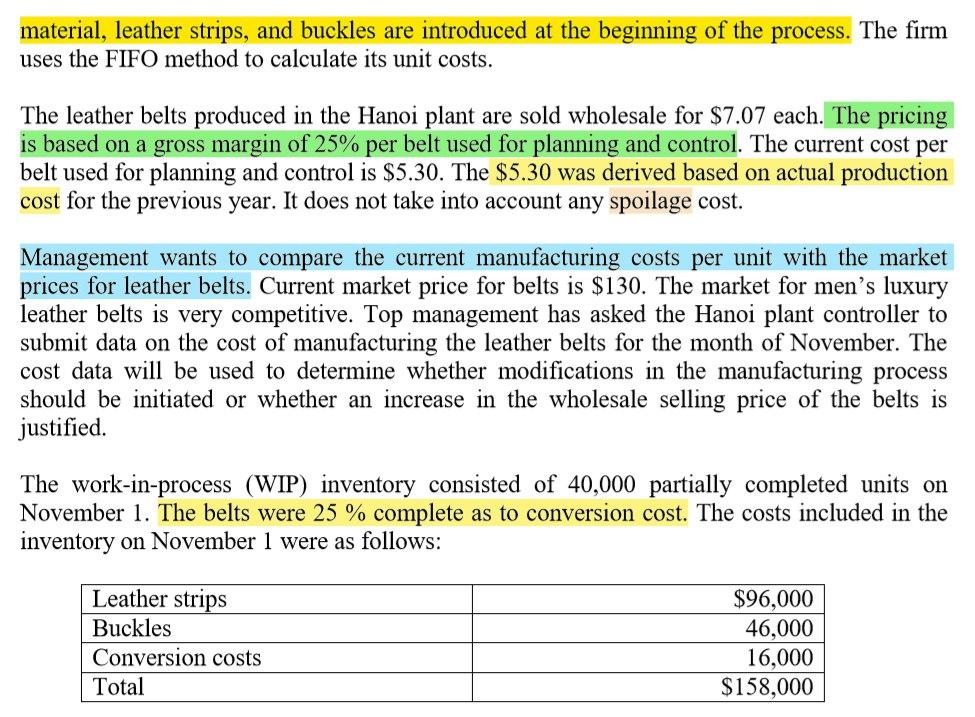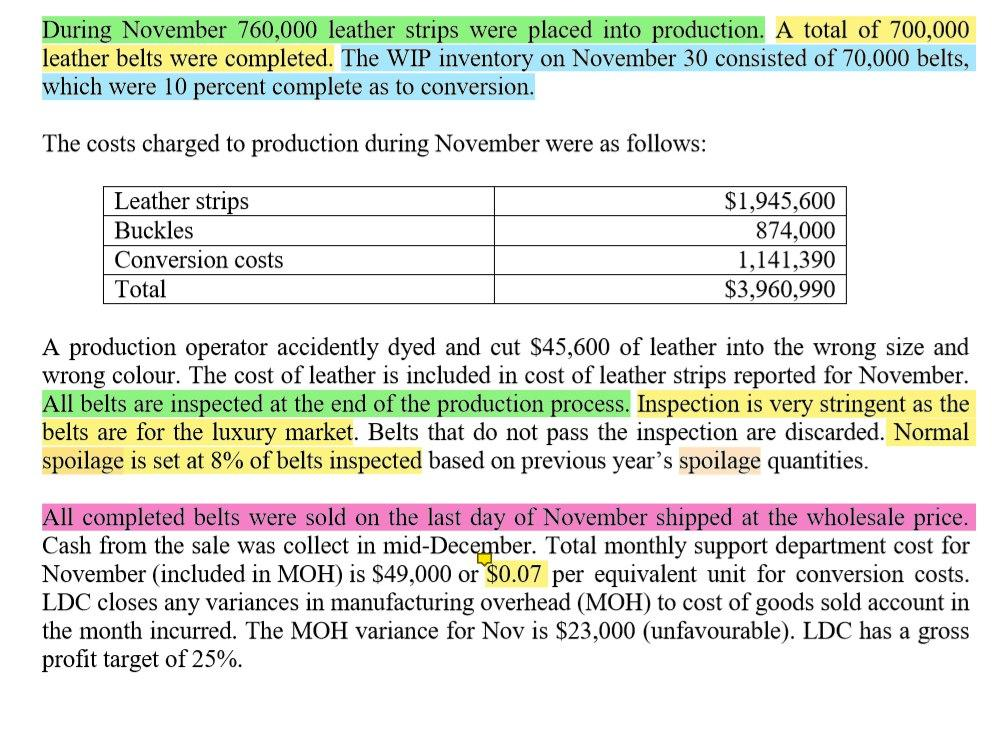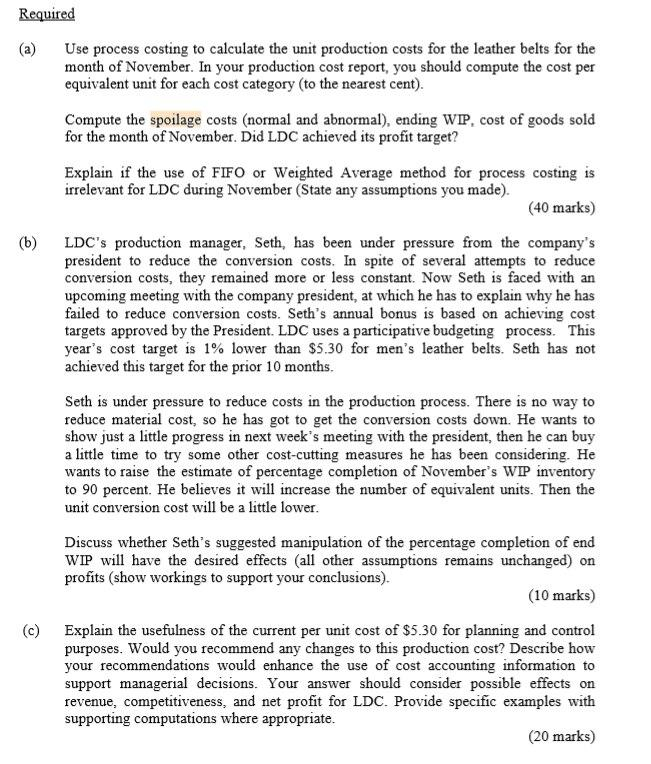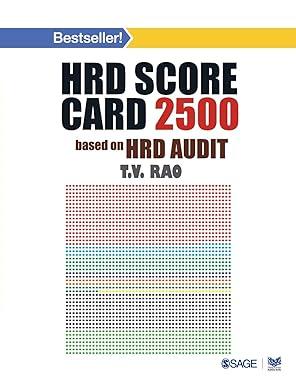Answered step by step
Verified Expert Solution
Question
1 Approved Answer
Hi please help on this managerial accounting tutorial question, thank you Question Luck Dat Company (LDC') manufactures high-quality leather goods. The company's profits have declined




Hi please help on this managerial accounting tutorial question, thank you
Question Luck Dat Company (LDC') manufactures high-quality leather goods. The company's profits have declined during the last six months. In an attempt to isolate the causes of poor profit performance, management is investigating the manufacturing operations of each of its products. One of the company's main products is men's luxury leather belts. The belts are produced in a single, continuous process in the Hanoi plant. During the process, leather strips are sewn, punched, and dyed. The belts then enter a final finishing stage to conclude the process. Labour and overhead are applied continuously during the manufacturing process. All material, leather strips, and buckles are introduced at the beginning of the process. The firm uses the FIFO method to calculate its unit costs. The leather belts produced in the Hanoi plant are sold wholesale for $7.07 each. The pricing is based on a gross margin of 25% per belt used for planning and control. The current cost per belt used for planning and control is $5.30. The $5.30 was derived based on actual production cost for the previous year. It does not take into account any spoilage cost. Management wants to compare the current manufacturing costs per unit with the market prices for leather belts. Current market price for belts is $130. The market for men's luxury leather belts is very competitive. Top management has asked the Hanoi plant controller to submit data on the cost of manufacturing the leather belts for the month of November. The cost data will be used to determine whether modifications in the manufacturing process should be initiated or whether an increase in the wholesale selling price of the belts is justified. The work-in-process (WIP) inventory consisted of 40,000 partially completed units on November 1. The belts were 25 % complete as to conversion cost. The costs included in the inventory on November 1 were as follows: Leather strips Buckles Conversion costs Total $96,000 46,000 16,000 $158,000 During November 760,000 leather strips were placed into production. A total of 700,000 leather belts were completed. The WIP inventory on November 30 consisted of 70,000 belts, which were 10 percent complete as to conversion. The costs charged to production during November were as follows: Leather strips Buckles Conversion costs Total $1,945,600 874,000 1,141,390 $3,960,990 A production operator accidently dyed and cut $45,600 of leather into the wrong size and wrong colour. The cost of leather is included in cost of leather strips reported for November. All belts are inspected at the end of the production process. Inspection is very stringent as the belts are for the luxury market. Belts that do not pass the inspection are discarded. Normal spoilage is set at 8% of belts inspected based on previous year's spoilage quantities. All completed belts were sold on the last day of November shipped at the wholesale price. Cash from the sale was collect in mid-December. Total monthly support department cost for November (included in MOH) is $49,000 or $0.07 per equivalent unit for conversion costs. LDC closes any variances in manufacturing overhead (MOH) to cost of goods sold account in the month incurred. The MOH variance for Nov is $23,000 (unfavourable). LDC has a gross profit target of 25%. Required (a) Use process costing to calculate the unit production costs for the leather belts for the month of November. In your production cost report, you should compute the cost per equivalent unit for each cost category (to the nearest cent). Compute the spoilage costs (normal and abnormal), ending WP, cost of goods sold for the month of November. Did LDC achieved its profit target? Explain if the use of FIFO or Weighted Average method for process costing is irrelevant for LDC during November (State any assumptions you made). (40 marks) (b) LDC's production manager, Seth, has been under pressure from the company's president to reduce the conversion costs. In spite of several attempts to reduce conversion costs, they remained more or less constant. Now Seth is faced with an upcoming meeting with the company president, at which he has to explain why he has failed to reduce conversion costs. Seth's annual bonus is based on achieving cost targets approved by the President. LDC uses a participative budgeting process. This year's cost target is 1% lower than $5.30 for men's leather belts. Seth has not achieved this target for the prior 10 months. Seth is under pressure to reduce costs in the production process. There is no way to reduce material cost, so he has got to get the conversion costs down. He wants to show just a little progress in next week's meeting with the president, then he can buy a little time to try some other cost-cutting measures he has been considering. He wants to raise the estimate of percentage completion of November's WIP inventory to 90 percent. He believes it will increase the number of equivalent units. Then the unit conversion cost will be a little lower. Discuss whether Seth's suggested manipulation of the percentage completion of end WIP will have the desired effects all other assumptions remains unchanged) on profits (show workings to support your conclusions). (10 marks) (c) Explain the usefulness of the current per unit cost of $5.30 for planning and control purposes. Would you recommend any changes to this production cost? Describe how your recommendations would enhance the use of cost accounting information to support managerial decisions. Your answer should consider possible effects on revenue, competitiveness, and net profit for LDC. Provide specific examples with supporting computations where appropriate. (20 marks) Question Luck Dat Company (LDC') manufactures high-quality leather goods. The company's profits have declined during the last six months. In an attempt to isolate the causes of poor profit performance, management is investigating the manufacturing operations of each of its products. One of the company's main products is men's luxury leather belts. The belts are produced in a single, continuous process in the Hanoi plant. During the process, leather strips are sewn, punched, and dyed. The belts then enter a final finishing stage to conclude the process. Labour and overhead are applied continuously during the manufacturing process. All material, leather strips, and buckles are introduced at the beginning of the process. The firm uses the FIFO method to calculate its unit costs. The leather belts produced in the Hanoi plant are sold wholesale for $7.07 each. The pricing is based on a gross margin of 25% per belt used for planning and control. The current cost per belt used for planning and control is $5.30. The $5.30 was derived based on actual production cost for the previous year. It does not take into account any spoilage cost. Management wants to compare the current manufacturing costs per unit with the market prices for leather belts. Current market price for belts is $130. The market for men's luxury leather belts is very competitive. Top management has asked the Hanoi plant controller to submit data on the cost of manufacturing the leather belts for the month of November. The cost data will be used to determine whether modifications in the manufacturing process should be initiated or whether an increase in the wholesale selling price of the belts is justified. The work-in-process (WIP) inventory consisted of 40,000 partially completed units on November 1. The belts were 25 % complete as to conversion cost. The costs included in the inventory on November 1 were as follows: Leather strips Buckles Conversion costs Total $96,000 46,000 16,000 $158,000 During November 760,000 leather strips were placed into production. A total of 700,000 leather belts were completed. The WIP inventory on November 30 consisted of 70,000 belts, which were 10 percent complete as to conversion. The costs charged to production during November were as follows: Leather strips Buckles Conversion costs Total $1,945,600 874,000 1,141,390 $3,960,990 A production operator accidently dyed and cut $45,600 of leather into the wrong size and wrong colour. The cost of leather is included in cost of leather strips reported for November. All belts are inspected at the end of the production process. Inspection is very stringent as the belts are for the luxury market. Belts that do not pass the inspection are discarded. Normal spoilage is set at 8% of belts inspected based on previous year's spoilage quantities. All completed belts were sold on the last day of November shipped at the wholesale price. Cash from the sale was collect in mid-December. Total monthly support department cost for November (included in MOH) is $49,000 or $0.07 per equivalent unit for conversion costs. LDC closes any variances in manufacturing overhead (MOH) to cost of goods sold account in the month incurred. The MOH variance for Nov is $23,000 (unfavourable). LDC has a gross profit target of 25%. Required (a) Use process costing to calculate the unit production costs for the leather belts for the month of November. In your production cost report, you should compute the cost per equivalent unit for each cost category (to the nearest cent). Compute the spoilage costs (normal and abnormal), ending WP, cost of goods sold for the month of November. Did LDC achieved its profit target? Explain if the use of FIFO or Weighted Average method for process costing is irrelevant for LDC during November (State any assumptions you made). (40 marks) (b) LDC's production manager, Seth, has been under pressure from the company's president to reduce the conversion costs. In spite of several attempts to reduce conversion costs, they remained more or less constant. Now Seth is faced with an upcoming meeting with the company president, at which he has to explain why he has failed to reduce conversion costs. Seth's annual bonus is based on achieving cost targets approved by the President. LDC uses a participative budgeting process. This year's cost target is 1% lower than $5.30 for men's leather belts. Seth has not achieved this target for the prior 10 months. Seth is under pressure to reduce costs in the production process. There is no way to reduce material cost, so he has got to get the conversion costs down. He wants to show just a little progress in next week's meeting with the president, then he can buy a little time to try some other cost-cutting measures he has been considering. He wants to raise the estimate of percentage completion of November's WIP inventory to 90 percent. He believes it will increase the number of equivalent units. Then the unit conversion cost will be a little lower. Discuss whether Seth's suggested manipulation of the percentage completion of end WIP will have the desired effects all other assumptions remains unchanged) on profits (show workings to support your conclusions). (10 marks) (c) Explain the usefulness of the current per unit cost of $5.30 for planning and control purposes. Would you recommend any changes to this production cost? Describe how your recommendations would enhance the use of cost accounting information to support managerial decisions. Your answer should consider possible effects on revenue, competitiveness, and net profit for LDC. Provide specific examples with supporting computations where appropriate. (20 marks)Step by Step Solution
There are 3 Steps involved in it
Step: 1

Get Instant Access to Expert-Tailored Solutions
See step-by-step solutions with expert insights and AI powered tools for academic success
Step: 2

Step: 3

Ace Your Homework with AI
Get the answers you need in no time with our AI-driven, step-by-step assistance
Get Started


